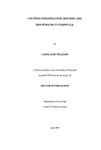Counter-urbanisation, housing and households in Cornwall
| dc.contributor.author | Williams, Carol | |
| dc.contributor.other | Faculty of Science and Engineering | en_US |
| dc.date.accessioned | 2011-05-12T11:18:44Z | |
| dc.date.available | 2011-05-12T11:18:44Z | |
| dc.date.issued | 1997 | |
| dc.identifier | Not available | en_US |
| dc.identifier.uri | http://hdl.handle.net/10026.1/420 | |
| dc.description.abstract |
Over the last thirty years Cornwall has experienced a dramatic population expansion. Population growth has had effects in many areas, but particularly in housing. The increased demand for housing from those migrating into the area has inflated house prices, yet the Cornish economy is afflicted by low wage levels and high unemployment rates, creating a `mortgage gap' for long term residents. This coupled with the decline in availability of both publicly and privately rented accommodation has resulted in what has been termed a housing `crisis' (George 1987, Deacon et al. 1988, Lennon 1991, Williams 1993). It has been suggested that this `crisis' has resulted in a `two tier' housing system, recent inmigrants generally enjoying better housing chances than longer term residents of Cornwall (Williams, 1993). Furthermore, it has been suggested that much of Cornwall's housing problems remain `hidden' having been absorbed into existing household structures. The research presented in this thesis aimed to assess the housing circumstances and chances of both recent in-migrant and long-term residents in order to discover if they do in fact differ. Whether or not housing need was being absorbed into existing household structures was also explored, as were the reasons why. It was found that the housing circumstances and chances of recent in-migrants are generally better than those of long-term residents and that this was as a result of the distinctly different economic characteristics of the groups. Housing need was also found to be to a large extent 'concealed'. This was mainly young adults who were unable to set up independent households as a result of a lack of affordable accommodation. The research suggests that families remain a source of support and assistance to their members in relation to housing, but that the type of support given varies according to occupational class and economic means which might serve to disadvantage long-term residents still further in the future. | en_US |
| dc.description.sponsorship | University Research Studentship (HEFCE) with additional funding from the former Department of Applied Social Science | en_US |
| dc.language.iso | en | en_US |
| dc.publisher | University of Plymouth | en_US |
| dc.subject | Homelessness | |
| dc.subject | Housing | |
| dc.subject | Regional planning | |
| dc.subject | Housing need | |
| dc.subject | Cornwall | |
| dc.subject | Settlement patterns | en_US |
| dc.title | Counter-urbanisation, housing and households in Cornwall | en_US |
| dc.type | Thesis | |
| dc.identifier.doi | http://dx.doi.org/10.24382/4726 |
Files in this item
This item appears in the following Collection(s)
-
01 Research Theses Main Collection
Research Theses Main


